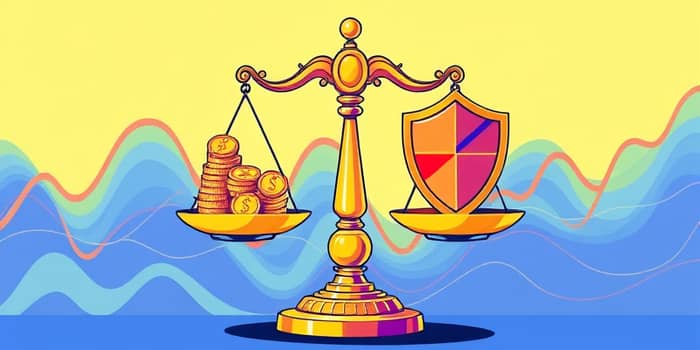Inflation is a powerful economic force that touches every aspect of our financial lives. In this article, we explore its causes, effects, and the practical strategies you can use to shield your hard-earned money from its erosive effects.
Definition and Measurement
At its core, inflation is the general increase in prices for goods and services, which leads to a decrease in currency purchasing power. As prices rise, each dollar buys less than before, influencing budgets, savings, and investments across the board.
Economists and policymakers track inflation through key indicators like the Consumer Price Index (CPI) and the Producer Price Index (PPI), both of which monitor the average change in prices for a representative basket of items over time.
Key Causes of Inflation
Inflation arises from a variety of sources. Understanding these drivers can help you anticipate shifts in price levels and adjust your financial plans accordingly.
- Demand-Pull Inflation: Occurs when consumer demand outpaces available supply, often following periods of fiscal stimulus or surges in spending. For example, the 2021 post-pandemic stimulus boosted disposable income, pushing the CPI upward.
- Cost-Push Inflation: Triggers price hikes when businesses face rising input costs like labor and materials and pass these higher expenses onto consumers. The sharp rise in oil prices from $70 to over $120 per barrel in early 2022 illustrates this phenomenon.
- Inflation Expectations: When households and firms anticipate higher future prices, they negotiate wages and prices accordingly, sometimes creating a self-fulfilling spiral of rising costs.
- Supply Shocks: Events such as natural disasters, geopolitical conflicts, or pandemics can disrupt production and distribution networks, leading to sudden price spikes in key goods.
- Wage-Price Spiral: As workers demand higher wages to keep up with living costs, businesses respond by raising prices, which in turn fuels further wage demands and sustained inflationary pressure.
- Monetary Supply Expansion: Excessive growth in the money supply, whether through central bank asset purchases or government spending, means more currency chases the same amount of goods, igniting inflation.
- Fiscal and Policy Shocks: Measures like tariffs, sudden currency devaluation, or unanticipated regulatory changes can produce both demand-pull and cost-push effects, complicating the inflationary landscape.
Effects of Inflation
High or volatile inflation can reshape economic behavior and long-term planning. The following list outlines key consequences for individuals and the broader economy:
- Erosion of purchasing power, where rising prices diminish the real value of wages and savings.
- Reduced real returns on investments, as nominal returns lag behind inflation, especially hurting those on fixed incomes like retirees.
- Increased cost of living for essentials such as housing, food, and healthcare, straining household budgets.
- Declining real earnings when wage growth fails to match inflation, impacting quality of life and consumer morale.
- Heightened economic uncertainty, undermining business investment decisions and consumer confidence.
- Rapid devaluation of cash savings, unless those funds earn competitive interest rates that keep pace with price hikes.
Historical and Recent Data
Inflation has fluctuated significantly over past decades. Notably, the 1970s witnessed a persistent wage-price spiral in the U.S., with annual rates exceeding 13% at their peak. More recently, global supply disruptions and energy price shocks pushed inflation in many advanced economies above 8% in 2022—a level unseen in decades.
Central banks often target a 2% annual inflation rate, using policy tools to moderate extreme deviations. However, real-world shocks can push rates well above or below these targets, underscoring the complexity of modern economies.
Strategies to Protect Purchasing Power
While inflation cannot be eliminated entirely, there are practical steps you can take to preserve your financial well-being.
- Diversify Investments: Allocate a portion of your portfolio to hard assets like gold real estate and commodities, which tend to hold value when fiat currencies decline.
- Inflation-Protected Securities: Invest in Treasury Inflation-Protected Securities (TIPS) and similar bonds that adjust principal and interest payments to match official inflation measures.
- Savings Accounts & Cash Management: Maintain an emergency fund in high-yield accounts to earn interest that helps offset inflationary erosion.
- Budgeting & Expense Control: Regularly review spending, lock in prices for recurring costs, and minimize idle cash balances during periods of rising prices.
- Inflation-Adjusted Annuities: Consider retirement annuities designed to increase payouts in line with inflation for long-term income stability.
- Global Diversification: Expand into international equities and bonds to benefit from economies experiencing lower inflation at different times.
- Commodities Exposure: A strategic allocation to energy, agricultural, and industrial metals can provide a buffer when consumer prices broadly rise.
Policy and Institutional Responses
Governments and central banks play a critical role in shaping inflation dynamics. By raising interest rates, central banks can cool excessive demand but risk slowing economic growth and increasing borrowing costs for consumers and businesses.
Long-term solutions to cost-push pressures often involve supply-side investments in infrastructure and initiatives to diversify supply chains, reducing vulnerability to shocks.
Transparent communication and anchor inflation expectations is crucial to maintain public trust and ensure that wage and price negotiations remain grounded in realistic outlooks.
Additional Considerations
Beyond inflation, it is important to understand related phenomena such as deflation, which occurs when prices decline and can lead to reduced economic activity. The Quantity Theory of Money explores the relationship between money supply and price levels, providing theoretical underpinnings for policy decisions.
Distinguishing between real and nominal rates—whether in wages, investment returns, or debt obligations—reveals the true impact of price changes on purchasing power. Demographic groups, particularly retirees and low-income households, often feel inflation most acutely due to fixed budgets and limited income growth.
Finally, behavioral responses, including preemptive buying or delayed consumption, shape demand patterns during high-inflation periods. By staying informed and proactive, individuals and policymakers alike can navigate inflationary challenges and work toward a more stable financial future.














